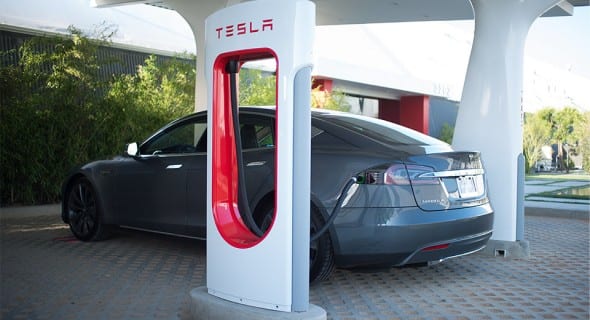Hot on the heels of its surprise quarterly profit announcement and last week’s battery storage bombshell, Tesla has come out with two new announcements this week that add to its new image of a tech upstart that is finally coming of age.
The first, published on the blog on Monday, revealed changes to the company’s supercharging network, which will, starting next year, cost new Tesla EV drivers a “small fee” to use, having been – until now – completely free.

According to the blog, Teslas ordered after January 1 2017, will be given 400kWh of free Supercharging credits per annum – which for some Model S drivers will amount to just one free (full) recharge a year. Current Tesla owners and those who order before January 2017 and take delivery before April 2017 are exempt from the changes.
Beyond that, Tesla says it will cost new customers “a small fee” to use the Superchargers – which can top up a nearly empty battery in around 30 minutes – and that fee “will be charged incrementally and cost less than the price of filling up a comparable (petrol) car.”
As Wired magazine has noted, on the face of it, this may seem like a fairly unsexy update; here was a service that approached the convenience of putting petrol into a conventional car, and was free for life! And they’re taking it away?
“But this isn’t Tesla giving up on its promises or Elon turning Ebenezer,” writes Wired’s Jack Stewart. “This is Tesla growing up – along with the American electric vehicle industry.”
Indeed, Elon says as much in the company blog post, describing the change as “one that allows us to reinvest in the network, accelerate its growth and bring all owners, current and future, the best Supercharging experience.”
This means more Superchargers, but it also encourages Tesla owners to do their day-to-day charging at home, instead of using and abusing the superchargers – something the company has expressed frustration with before. And now, with the company’s markedly cheaper home battery storage and solar roofs, customers might be more inclined to plug in at home.
But the change is also a sign of Elon’s new emphasis on cost cutting and turning a profit. After all, superchargers are expensive.
“Having a supercharger turn on is like putting five to 10 US homes on the grid,” said Paul Mutolo, an energy storage chemist at Cornell University, quoted on Wired. “(Tesla’s) demand charges have got to be quite hefty,” he said.
Tesla says the costs and other details of the re-jigged Supercharger program will be released later this year, and notes that while prices may fluctuate over time and vary regionally based on the cost of electricity, its Supercharger Network “will never be a profit center.”
Tesla’s second update this week, published on the blog Tuesday, announced its acquisition of German auto assembly company, Grohmann Engineering, as part of Elon Musk’s plan to boost productivity by reinventing the factory.
As Musk wrote in the blog, Grohmann is one of the world leaders in automated manufacturing, so this purchase will bring its “world-class team and unique expertise in-house.”
Moreover, he added, “it will serve as the initial base for Tesla Advanced Automation Germany headquarters, with other locations to follow. We expect to add over 1,000 advanced engineering and skilled technician jobs in Germany over the next two years.
The move will see several critical elements of Tesla’s automated manufacturing systems designed and produced in Prüm, to help make Tesla’s factories “the most advanced in the world,” Musk said.
“Combined with our California and Michigan engineering facilities, as well as other locations to follow, we believe the result will yield exponential improvements in the speed and quality of production, while substantially reducing the capital expenditures required per vehicle.”










